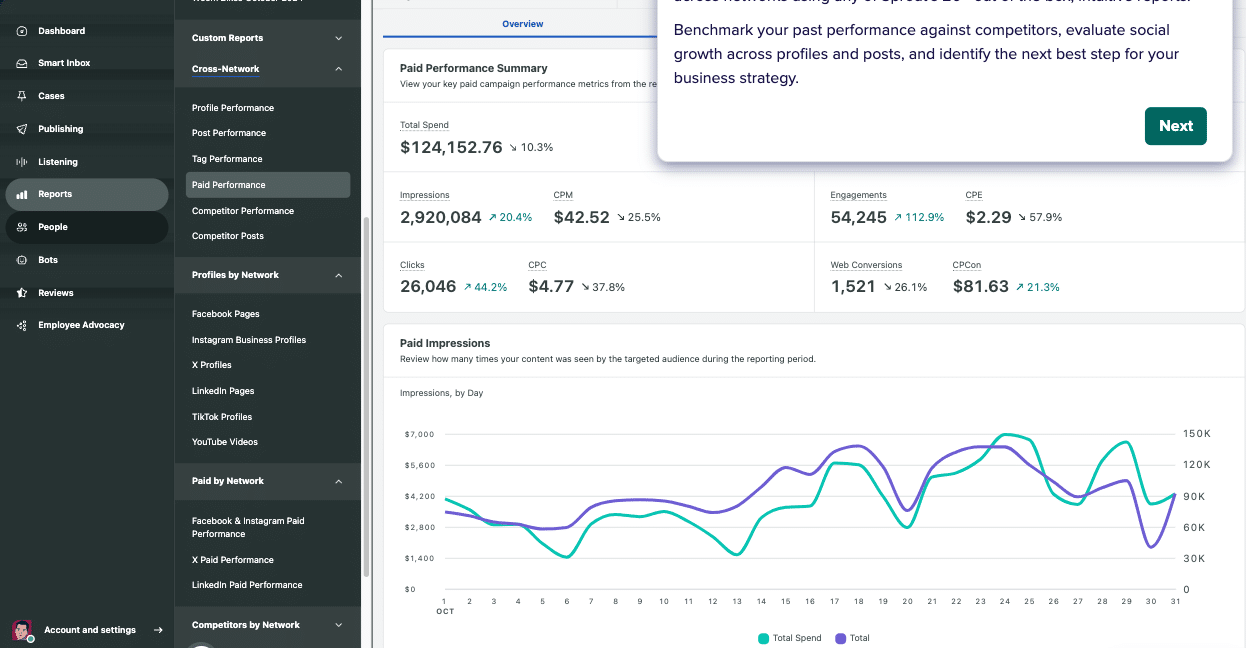Executed properly, a content marketing campaign can open a lot of doors for your overall marketing goals and key performance indicators (KPIs) — driving leads, raising awareness, and boosting sales. Whether you’re diving into the world of content marketing fresh, or you’ve been using content marketing for a while but find your results falling flat, you’ll need to institute a solid content marketing strategy to see the best results.
To create a content marketing strategy, you’ll need to define your audience, determine the information they want to see from you (and the formats they want to see it in!), and then create KPIs so you can measure the success of your campaign. Learning how to develop a content marketing strategy doesn’t have to be painful: Follow the steps below to ensure every piece of content your marketing and writing teams create helps you meet your company’s goals and business objectives.
What Is a Content Marketing Strategy?
A content marketing strategy is your blueprint for inbound content marketing. It encompasses your metrics, goals, objectives, key audience, competitors, and the types of content you’ll create.
As you dive deep into creating your content marketing strategy, you might be surprised by some of the elements you’ll need to consider. This includes not just how well your content resonates with your readers, but the overall user experience, SEO, how well your content ranks with AI-based search algorithms, and, in general, how your brand shows up across channels.
Why Have a Content Marketing Strategy?
Your content marketing strategy drives your content initiatives, giving you a roadmap for success. “Creating content without a strategy is like navigating without a compass,” says Treasa Edmond, content strategy consultant and founder of Boss Responses and Strategy Bosses. “You might eventually get somewhere, but it probably won’t be where you intended to go.”
Many companies mistake a simple content plan as their entire content marketing strategy, which can be a dangerous and costly mistake. Your content plan is all about execution — what types of content will help you achieve your objective, who will create that content, how it will be distributed, etc. A content marketing strategy, on the other hand, is the tactical playbook that brings the enterprise to life, the architectural blueprint that ensures everything serves a purpose.
Your content strategy should be a well-researched, intentional guide for how your organization will use content to achieve specific business objectives. “If you take the time to get it right, it will transform how you approach content creation and distribution,” Edmond adds.
6 Steps to Creating a Successful Content Marketing Strategy
Creating a successful content marketing strategy doesn’t happen overnight. Depending on how much your company invests, it can take months, and is likely to change with market conditions, your company’s offerings, or search algorithm changes. These six steps can help you get started.
Develop Your Audience Persona
Your content strategy must begin with an analysis of your target market, or the audience persona you are trying to reach. Without this important step, your content may not speak to your audience’s pain points. Persona-based marketing campaigns delivered 100% more page views, a 900% increase in site visit duration, and 171% growth in marketing ROI, according to SEMRush. If your organization doesn’t have audience personas in place, it’s time to dig into some heavy research.
“You’re not just creating demographic profiles, you’re telling the story of your audience’s challenges, aspirations, and their decision-making processes,” says Edmond. “That then informs your content.”
You can use various tools and resources to drill down on personas, including:
- Surveys.
- Existing buyer personas from your sales and marketing departments.
- Social media research.
- Interviews with customers.
At this stage, tools like Sprout Social and HootSuite can help gauge market sentiment and find out what your audience is saying about your brand.
Perform a Content Audit
You won’t know what direction to take your content in unless you know what’s already working — and not working — on your website and social media channels. During the audit, you’ll want to look at every piece of content, including:
- Landing pages.
- Blog posts.
- Content (like guest posts) on third-party sites.
- Videos (on-site and on third-party sites).
- Social media content.
Along with creating audience personas, the content audit is one of the most time-intensive elements of developing your content strategy. For websites with thousands of pages of content, you may want to do spot checks of blog posts rather than analyzing every single post.
During the audit, look for content that resonates with your audience, content that may no longer fit your brand, and gaps in the content journey that need to be filled. Notice “which pieces are currently driving meaningful business results, and which pieces of content have fallen flat and may need to be revised or removed,” advises Edmond. Map out each piece of content to see where it fits in the customer journey. Do you have a good mix of top-of-the-funnel, middle-of-the-funnel, and bottom-of-the-funnel content?
Do Competitor Analysis
Next, you’ll want to see how your content stands up against competitors, both in terms of search engine rankings and value. You can use tools like SEMRush to find content gaps, but don’t be surprised if, during the analysis, you identify competitors that weren’t top-of-mind previously. Some competitors may address the same pain points and solve the same problems as your brand, but with different offerings. To make the competitor analysis manageable, limit your evaluation to three to five competitors.
Set Goals for Your Content
Before you begin planning content, you’ll want to establish goals. What objectives do you want your content to achieve? How will you measure success? Dive deeper than just page views or bounce rates: Choose metrics that will impact your business.
“Your goals should be specific and tied to business outcomes, whether that’s growing your email list, generating qualified leads, or establishing thought leadership in your industry,” Edmond points out.
Share Your Strategy with Your Team
Your content strategy won’t work if created in a vacuum. You’ll want to rely on input from sales and marketing team members when you’re creating the strategy, and when it comes time to share your documentation, Edmond says, “Don’t just throw the entire strategy document at them: Create a 30-minute training video on the parts of the strategy that apply to them.”
Alternatively, you can walk the teams through your plan, then set up regular check-ins with relevant stakeholders to ensure everyone knows what their goals are, and provide an outline of the strategy as a quick reference guide.
Execute Your Strategy
Finally, taking what you’ve learned, you’ll want to begin to plan the content assets that will help you speak to your audience and achieve your goals. Don’t forget to go back and track your results based on the metrics you determined were important, make adjustments as needed, and continue evolving your strategy as you learn more about what works and what doesn’t.
Content Strategy Tactics
Understanding how to develop a content marketing strategy is one thing, but taking the right next steps requires teamwork, a variety of apps and resources, and the right tactics for everything to come together.
Use a Buyer Journey Matrix to Create Your Content Plan
With your content strategy in hand, you’ll want to begin the task of content planning. A buyer journey matrix that addresses each stage of the sales funnel will help ensure you’re serving readers at every stage of their journey. At this point, outline the types of content, but not necessarily specific titles, that you’ll need for each stage of the journey.
Create Content Pillars
While looking at your existing content, plus the new assets you plan to create, generate a list of content pillars. These are the main themes your content will address. Every piece of content on your site should point back to one of the pillars and expand on this broad theme.
Plan to Generate New Content from Existing Content Assets
Before you set forth creating pages of new content, look at the content you already have. White papers, webinars, blog posts, case studies, videos, and podcasts can all be crafted into shorter posts, social media content, infographics, etc. It’s also helpful to bear this in mind when you first start planning new content: How else can it be presented, and where else can it live?
Choose the Right Distribution Channels
Once you’ve outlined the types of content you want to create — blog posts, case studies, infographics, white papers, etc. — take time to drill down on the best ways to distribute your content. Blog posts may live on your website, while guest posts are placed on other sites. You can write and distribute articles on LinkedIn, and you can share snippets of the info from these articles on your various other social media channels. The possibilities are endless, but remember, you don’t want to spread your marketing team too thin.
“Identify where your audience spends their time and focus your efforts there,” Edmond advises. “Quality distribution on a few key channels beats scattered presence everywhere.”
Tools to Measure Your Campaign’s Success
Getting a clear look into your content marketing’s ROI depends on your specific needs. Consider the following:
If you’re looking to measure sales:
Google Analytics can be your BFF. If you’re hooked up with a customer relationship management (CRM) platform like Salesforce or Hubspot, you’ll be able to connect to Google Analytics for a seamless glance at how efforts are leading directly to revenue. Even without a CRM tool, Google Analytics can still help bridge the gap. Setting up conversion goals (in this case, purchases) can help you directly track sales that stems from a specific URL.
If you’re targeting leads generated:
Similar to measuring sales or revenue, measuring leads generated lends itself to Google Analytics and a CRM tool. Setting up a conversion goal for the moment someone signals to you that they’re interested (effectively becoming a potential customer) is key to determining if your content marketing efforts are, in fact, leading to leads.
If you’re targeting site traffic:
Measuring your site traffic is a pretty great indicator of how you should optimize your content, and — you guessed it — Google Analytics is a pretty great tool here, too. Navigating to Behavior > Site Content > All Pages gets you to a traffic breakdown over time, as well as by URL, so you can clearly see where your traffic is coming from and attribute it to your content marketing efforts.
Advanced SEO tools like SEMRush can also help you track where traffic is coming from. Remember, though, that site traffic analysis is only helpful if you discover that you’re attracting the right people to your website, and that they’re taking action once they get there. Otherwise, site traffic might be considered a “vanity metric” that isn’t really helping you achieve business objectives.
If you’re targeting on-site engagement:
Want to know if consumers are engaged with your content? There are several ways to approach this. You can look at bounce rate, page views, time on page, and more to get a well-rounded sense of how the people you drove to your site actually engaged once they got there. The Audience Overview tab of Google Analytics is a fantastic place to see this information. You can break these metrics down by traffic source by navigating to Behavior > Site Content > All Sources, and filtering by Source/Medium.

If you’re targeting social media engagement:
There are a few ways you could break this down. Perhaps you’re interested in straightforward engagement rate, i.e., the total interactions on a post divided by follower count and multiplied by 100. Or, maybe you’re interested in how many new followers resulted from a specific campaign.
These metrics are relatively simple to track within social platforms themselves, but they’re greatly enhanced by social media management platforms like Sprout Social, Hootsuite, or Buffer. These platforms offer multiple ways to view data, including overviews like this one:

(Source: Sprout Social)
You can then, of course, get even more granular and look into how each post performed to round out the scope of understanding around your social media engagement.
If you’re targeting brand awareness or brand authority:
You want people to know who your brand is and/or to know that you’re an authority in your industry. This is the toughest KPI of all to measure (no quick Google Analytics trick for this one), but taking a look at things like PR coverage or a sentiment analysis can be really helpful. Tools like Cision for PR or Sprout Social for social media have these capabilities built in and can make the process go much more smoothly.
More on Content Marketing
Content marketing is a powerful tool for lead generation, brand recognition, and sales. By developing a strategy, you can ensure that every piece of content serves a purpose and helps your organization achieve its goals for increased sales, growth, and reputation building.
What Is Content Marketing?
Content marketing uses informative, authoritative content to help build the trust of your target audience. Examples of content marketing assets include:
- Blog posts.
- White papers.
- Case studies.
- Emails.
- Videos.
- Podcasts.
- Social media posts.
- Infographics.
Content marketing relies on free distribution, not paid advertising, with an emphasis on increasing organic search results, building a loyal audience, and keeping visitors on a website or a social media stream by offering helpful content.
How Does Content Marketing Work?
Content marketing seeks to engage and educate your audience without taking a hard sales approach, ultimately guiding them down the sales funnel until they become buyers and, ideally, brand evangelists. The best content will be shared across channels, elevating and amplifying your message. A well-executed content strategy can improve search engine rankings, build brand recognition, and identify your company as a trusted resource and industry leader.
Why Investing in Content Marketing is Important
If content marketing is new to your marketing team’s strategy, you’ve likely heard that it’s seen merely as a “nice to have,” or that there just “isn’t really a budget for it.” But the quickest way to kill the success of content marketing is to do it half-heartedly. Don’t mistakenly think that just anyone within your organization can whip up a social media campaign, or that whoever has the time to do so can write an engaging email.
When you’re creating content, be sure that it’s created by those who are qualified to do it. Haphazard content marketing efforts are easy to spot. You don’t have to devote the lion’s share of your marketing budget for your campaign to be successful, but you do have to recognize that content creation requires resources.
Content marketing and SEO
Search engine optimization, or SEO, plays a role in content marketing, but SEO shouldn’t drive your strategy. “SEO shouldn’t tell you what content to write,” Edmond points out. “But, it can help make your content more focused if you know the right search terms to use.”
Increasingly, SEO relies less on specific keywords and more on user-intent and semantically related search terms. Writing a post that’s optimized for Google’s “People Also Ask” section or Knowledge Center can help attract new eyes to your website. Keep in mind, 60% of Google searches in 2024 ended without a click-through to a website, according to a report from SparkToro. This means that, while ranking on Google’s first page remains important, it shouldn’t be the central focus of your inbound marketing strategy.
Content Marketing and Artificial Intelligence
The rise of AI, including Google’s new AI-generated search results, adds another layer to SEO for content marketers. Google’s AI algorithms look for content that achieves its purpose, answering a specific question for readers upfront, and showcasing expert authority. “More than ever, AI search results mean that SEO needs to be a holistic process, focused on user intent,” Edmond says.
Social Media and Content Marketing
With SEO being increasingly harder to master, a moving target that may not lead to the conversions you want, social media plays a growing role in content marketing. Social media should be included in your content audit and your strategy, but if you aren’t a social media strategist, you’ll want to bring in an expert to help with that portion of your content planning. “Whether it’s social media, SEO, or writing content, it’s always worth it to hire an expert for specialized tasks,” confirms Edmond.
Frequently Asked Questions (FAQs)
Do I Really Need to Create a Content Marketing Strategy?
Yes! Brands should develop a content marketing strategy before embarking on any content campaign, to ensure that the content is designed and distributed to meet their business objectives.
Do I Need to Share Our Content Marketing Strategy With Other Teams/Departments in my Company?
It’s important to share your content marketing strategy with other departments, including sales, customer support, and the c-suite. When each department understands the role the strategy plays in business development, they can benefit from that knowledge.
How Often Should I Update my Content Marketing Strategy?
Many companies update their content marketing strategy annually, but it’s best to do a monthly or quarterly review to ensure your strategy is still aligned with your business needs and market conditions.



